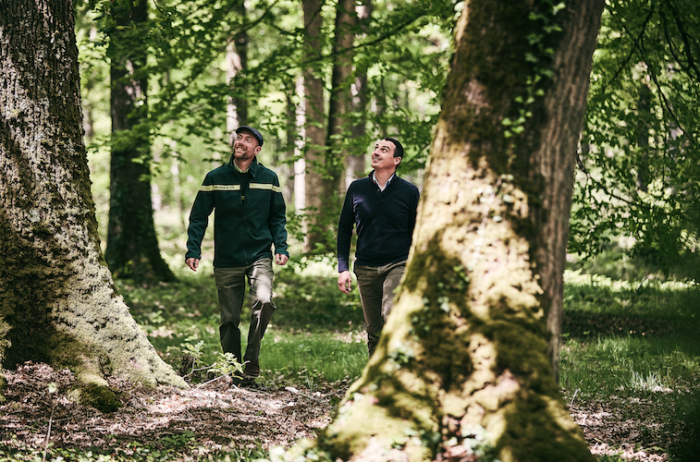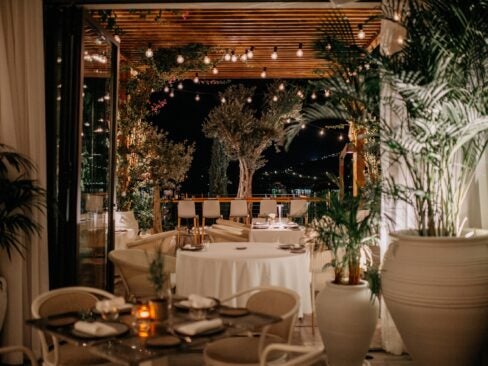Deep in the heart of Cognac, France, lies a place where time is not measured in weeks, months or even years, but in decades and centuries. Where a cellar master blends eaux-de-vie that have been aging for 70 years in casks that are over 100 years old, and plans each of his steps imagining what his successor’s successor’s successor might need in another 100 years. At the house of Louis XIII, time rules everything.
Walking into one of the cellars where its precious eaux-de-vie age, I am instantly struck by the humidity, the eerie stillness, the majesty of the towering, cobweb-covered casks and the overpowering smell of alcohol. A cellar might be the only place in France where no one would dream of smoking; you can’t even use the flash on your camera for fear of a spark in the air.
Here, among hundreds of casks, cellar master Baptiste Loiseau begins to speak about time. He looks at the tierçons and barriques as he speaks in a reverent tone about the house’s origins in 1874, his predecessors, his legacy, the precious liquid aging in ancient oak and how he is ensuring that he provides the next generation with the raw materials needed to create this special cognac. It is not as simple as aging eaux-de-vie every year.
The warming climate has changed the levels of acidity and sugar in the grapes, so he started a 20-year project growing different varietals to see which might produce enough acidity for cognac in the future. The oak trees need nearly 180 years to grow large enough to create a tierçon, and they need another half-century filled with eaux-de-vie to have the right level of seasoning to hold the final blend of Louis XIII. And that’s not even mentioning the thousands of barrels of eaux-de-vie aging in dozens of cellars dotted around the countryside, each needing attention, tasting, rotation and blending.

Cellar master Baptiste Loiseau (right) explores the woods in search of materials for new tierçons
The oldest eaux-de-vie in a bottle of Louis XIII are over 100 years old, which is practically a child when compared to the age of the tierçons that hold it. Tierçons are odd things. They are larger than a traditional 350-liter barrique; they are longer, the wood staves are thinner, they are far more fragile and they are far older: The last one made for Louis XIII was in 1917, during World War I. After that, the craft was lost as cooperages became more industrialized and created standard sizes, and something as finicky as a tierçon became a relic of a past era.
Why use a tierçon at all if they are so fragile? It is that fragility, the thinness of the wood — .6 inches instead of 1 inch — that changes the angel’s share and what Loiseau calls “the evolution of the aroma.” The tierçons at Louis XIII have aged and absorbed eaux-de-vie for over a century, so the wood itself is an integral part of the cognac.
“When you have wood that has such a long history and has seen so many different eaux-de-vie, it totally encapsulates all of these eaux-de-vie, because of course the wood has liquid inside. So by all of these rotations of eaux-de-vie and all of the Grande Champagne eaux-de-vie that have been stored in these tierçons, it is part of the history of Louis XIII, and of course, it will be part of the future,” Loiseau says.
In the 1960s, then-cellar master André Giraud noticed some of the tierçons were leaking because of damage caused by stacking them. The only way to repair a tierçon is to cannibalize another, to ensure that the wood is the same age and has the same seasoning.
Loiseau says: “We have to store these tierçons one by one because they are fragile, because they are more than one century old, not to destroy them. We are limited to the tierçons we have in the cellar, and it’s really impossible to find other old tierçons at a cooperage or in a winegrower’s estate. The only way to repair a tierçon that is leaking is to sacrifice another one. So little by little, we were destroying the potential of the tierçons we had in the cellar.”
In 2013, he realized that the house would eventually run out, and he needed to act to revive the lost art of the tierçon. He needed “to ensure that for the next generation, they will have the raw materials to keep Louis XIII consistent,” he says. The project took four years to develop, and required the help of an archivist historian, the French National Forests Office, a 180-year old cooperage and Louis XIII’s own master coopers.

Smoke billows from a tierçon as a cooper toasts it

The old tierçons at Louis XIII have aged and absorbed eaux-de-vie for over a century
France has a notion of patrimoine, which translates to patrimony, but means so much more. The French are fiercely proud of their culture, their gastronomy, their wine, their haute couture. They cherish the heritage and craftsmanship behind these métiers d’art. They search for excellence, and if something is more expensive and time-consuming and it only makes something a tiny bit better, they still will, without question, do it. There is no cost too great or art too arcane. For me, the project of the tierçon speaks to this sense of pride, this patrimoine.
Oak seems so simple, so plain, so generic, until I stand beneath towering trees in a Limousin forest. Anthony Auffret, a director in the National Forests Office, explains the patrimoine behind cultivating a forest like this. He references notes from dozens of past forest managers — who described the ecology, their practices for maintaining the forest, how to decide which trees to keep and which to cut — and he does the same to help preserve the forest’s future. Auffret explains what he looks for in trees, pointing out that something like a small branch in the middle of the tree would disqualify it from being used to make a tierçon.
After being awed by these ancient trees, we walk to a field owned by Louis XIII, where we plant oak saplings. They are six years old, and they are frail, wispy things, more like houseplants than trees. We plant them in tidy rows and surround them with fences to protect from animals who love to eat the oaks’ leaves. As we look at our tiny trees, it’s an odd feeling, knowing that they will stay here for nearly 200 years before they can be judged worthy of becoming a tierçon.
That peculiar feeling is what Loiseau feels every day, working in between the past and the future. He will never know the results of some of his grape-growing projects, taste the final blends of the eaux-de-vie he carefully maintains or see a tierçon fashioned from his oak trees. But he understands this better than most, because cognac is in his blood. He was born and raised in the region, so from a young age he understood that cognac takes time, and the finest cognac takes a long time. As we taste the eaux-de-vie, he says, “We are drinking time. Time is our raw material.”
At the cooperage, Seguin Moreau, surrounded by towers of wood planks, we watch as the ancient oak planks transform into a tierçon through fire, machines, hammers and saws. But even here, time hangs heavy. The master coopers explain that everything is different about a tierçon, from the size to the time the wood needs to age after being cut — three more years — to the seasoning. Seguin Moreau makes 15-17 tierçons a year, but it can make 200 traditional barrels a day for its other clients. The majority of the work is done by hand using traditional techniques, and it is back-breaking work.

A finished bottle of Louis XIII cognac
Now that Loiseau has mastered the art of creating a tierçon, he enters uncharted territory by aging eaux-de-vie within the new oak tierçons. “I’m going to be surprised by this tierçon,” he tells me. “It’s more than one century without having these new oak tierçons in the cellar, so we have lost a bit of this know-how, this understanding of how it will evolve. These will be the best surprises I have in the next years and decades.
“Maybe I have in mind that they will be ready in the next 40-50 years to welcome the oldest eaux-de-vie into the final blend of Louis XIII, but it’s just my intuition. Maybe the next cellar master, he or she will decide that it is not the right time and they need much more time to be seasoned. Before, we were only focused on how to guide the eaux-de-vie, and now the role of the cellar master is also to guide the tierçon and learning how it will behave throughout the ages.”
What do hundreds of years growing oak trees, decades of aging and blending eaux-de-vie, and the life’s work of generations of cellar masters produce? An exquisite Baccarat crystal decanter, shaped after a 16th-century flask, that holds one of the world’s finest cognacs. Its bouquet is intense and complex, full of floral and honey notes, with a lingering finish and an incredible smoothness. But savoring the rich cognac is not just about flavors or aromas. It’s impossible to take a sip without thinking about the incredible amount of work, and yes, time, that went into creating this cognac. I feel immediately more present in the moment, my senses heightened, and I experience a sense of reverence as we taste each drop, discovering new layers each time.
Images: Rémy Martin, Stéphane Charbeau










